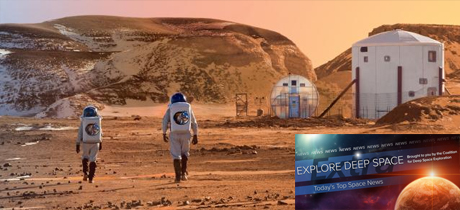In Today’s Deep Space Extra… 2033 seems to be a supportable target date for first U.S. human Mars venture.
Human Deep Space Exploration
The Space Review (5/15): Several recent events suggest that NASA, the agency’s policy makers and its commercial partners are gaining comfort with 2033 as a target date for the first human mission to the Martian realm. The date is contained in NASA’s 2017 authorization act and was referenced during last week’s Explore Mars: Human to Mars summit in Washington, as well as a NASA news briefing regarding plans for Exploration Mission-1, the first joint test flight of NASA’s Space Launch System and Orion crew vehicle. Some confusion over remarks from President Trump last month about making the journey by 2024 seem to have subsided. In a May 12 teleconference with reporters, Acting NASA Administrator Robert Lightfoot commented that the White House had not asked his agency to reach the red planet by 2024, TSR editor Jeff Foust notes in an op-ed.
Space Science
Did life ever exist on Mars? It could have
CBS News (5/14): Curiosity’s biggest discovery so far is that more than three billion years ago, Mars had all the building blocks necessary for life. Back then Mars and Earth were very similar—wet, warm, and habitable. But as life evolved on Earth, Mars became cold, dry and inhospitable. Did life ever exist on Mars? We don’t know—yet. But the rover is on the hunt and has been slowly maneuvering through a topographic treasure trove. This past weekend 60 Minutes shared stunning pictures and highlighted what Curiosity is telling us about Mars — and Earth.
Closest alien world to our solar system could be ripe for life, models suggest
Science (5/15): New scientific modeling suggests that the closest Earth-like planet to the solar system, Proxima b, which orbits the nearby star Proxima Centauri, could be ripe for life. The key is that water could exist in a liquid state on the rocky planet 1.3 times the mass of the Earth, though its host red dwarf star is much fainter than the sun. Proxima Centauri lies just over four light years from the sun.
Maryland senator seeks to maintain support for NASA programs
Space News (5/16): Maryland’s new senior U.S. Sen. Ben Cardin replaces the retired Barbara McKulski, who was a strong and long-running advocate for NASA’s space endeavors, especially those located in her state including the Hubble Space Telescope and its successor, the James Webb Space Telescope. In remarks before the Maryland Space Business Roundtable on Monday, Cardin promised to be aggressive in working with the state’s congressional delegation to protect the space program from funding cuts.
Video: How Made In Space plans to 3-D print huge structures in orbit
Geekwire (5/15): Coalition Member in the News
Made In Space, Inc., the California company that introduced 3-D printing to the International Space Station, is introducing Archinaut, a new strategy for the assembly of large space structures. The strategy is intended to remove some launch mass restrictions and replace the need for some spacewalks.
Low Earth Orbit
Russia’s ISS segment to become independent from U.S. communication satellites
TASS of Russia (5/16): Currently, Russia relies on ground stations and NASA’s own orbital tracking and data relay satellite system for broadband contact between the International Space Station’s Russian segment and Earth. Russia intends to have an independent Ku broadband capability by the end of this year.
SpaceX launches super-heavy communications satellite
Space.com (5/15): SpaceX boosted a weighty communications satellite into orbit late Monday to complete Inmarsat’s Global Xpress broadband network. The liftoff at 7:21 p.m., EDT, from NASA’s Kennedy Space Center did not include an effort to recover the Falcon 9 first stage booster.
Blue Origin suffers BE-4 testing mishap
Space News (5/15): Blue Origin reports a power pack loss during a May 13 test of BE-4 rocket engine hardware at company test facilities in West Texas. The BE-4, which burns methane and liquid oxygen, is under development for Blue Origin’s own New Glenn launch vehicle and possibly the United Launch Alliance Vulcan rocket.
The Space Review (5/15): The G-Hab hotel is a concept for a facility in Earth orbit that would offer future space tourists, researchers and workers off the planet a break from weightlessness, writes Bod Brodbeck, a semi-retired former data base developer and business systems manager. Equipped with a centrifuge and a counter-rotating flywheel, this facility would provide a half G to its customers.

